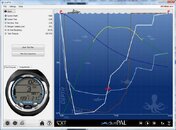GaryBDavis
Contributor
I just dove my first two dives with my new air integrated Oceanic VT4. My previous computer was the Atmos ai (also air integrated). So, similar computers but the Atmos ai shows the lesser of ATR and NDC minutes whereas the VT4 shows both separatedly.
I was diving nitrox 32 on two fairly deep (around 80 feet) dives with about an one hour surface interval. Towards the end of the second dive, the nitrogen loading bar hit four of five bars and set off the alarm (which I had provisioned). Now the next bar (the fith bar) is a decompression voilation, so I don't have anymore visual indications or warnings before I hit the NDL limit. So, we began a slow ascent and ended the dive with around 1000 PSI left. When I hit the fourth bar of the NDL limit, I noticed that I had about the same number of NDC minutes as I had ATR minutes remaining.
So, the question I have is in this situation, should I have extended my dive another 10 minutes - keeping my eye on the NDC and ATR minutes and not worried about the NDL bar being so high? Can I correctly assume that the NDL bar graph will hit the fith and last bar when the NDC minutes gets down to zero? From what I read, both the NDL bar and the NDC minutes take into account the previous dive nitrogen loading plus and SI and will adjust the readings according.
I realize that I could have gone up 20 feet or so to combat the nitrogen loading, but there just wasn't anything to see at that depth so I just decided to play it safe and end the dive. Afterall, it was the first time with a new computer.
I was diving nitrox 32 on two fairly deep (around 80 feet) dives with about an one hour surface interval. Towards the end of the second dive, the nitrogen loading bar hit four of five bars and set off the alarm (which I had provisioned). Now the next bar (the fith bar) is a decompression voilation, so I don't have anymore visual indications or warnings before I hit the NDL limit. So, we began a slow ascent and ended the dive with around 1000 PSI left. When I hit the fourth bar of the NDL limit, I noticed that I had about the same number of NDC minutes as I had ATR minutes remaining.
So, the question I have is in this situation, should I have extended my dive another 10 minutes - keeping my eye on the NDC and ATR minutes and not worried about the NDL bar being so high? Can I correctly assume that the NDL bar graph will hit the fith and last bar when the NDC minutes gets down to zero? From what I read, both the NDL bar and the NDC minutes take into account the previous dive nitrogen loading plus and SI and will adjust the readings according.
I realize that I could have gone up 20 feet or so to combat the nitrogen loading, but there just wasn't anything to see at that depth so I just decided to play it safe and end the dive. Afterall, it was the first time with a new computer.
Last edited:





